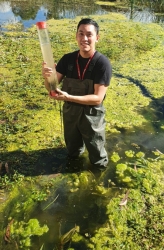news
Study find constructed wetlands reduce spread of microplastics

29 September 2022
A Griffith University study has found that constructed wetlands can act as a barrier to prevent microplastics from spreading further downstream, into our rivers and oceans
As constructed wetlands are a proven filters for other chemical contaminants from stormwater, the researchers investigated how well they collect and retain microplastics.
They found microplastic levels were up to four times higher in the storm/wastewater entering the wetland compared to water leaving the wetland. Similarly, the levels microplastics found in the constructed wetland sediment were higher than most reported freshwater sediment levels, with the amount of microplastics much greater in the sediment at the wetland inlet compared to the outlet.
The dominant form of microplastics was PET fibres primarily originating from clothing and textiles, however, PE and PP from the breakdown of large plastic items, such as food packaging and bottles, was also found in the sediment.
This study is an important first step that shows constructed wetlands can not only retain the microplastics in treated water and storm water runoff, but their sediment can also act as sinks trapping and accumulating the microplastics over time
Find out more in Griffith News
